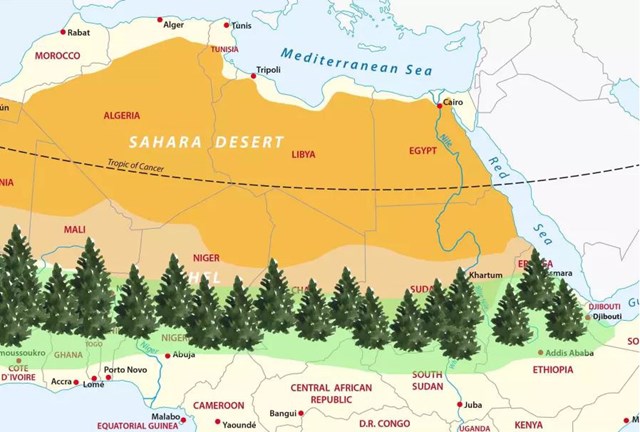
Large-scale, semi-arid forests could cool the planet. (photo credit: WEIZMANN INSTITUTE OF SCIENCE)
Planting the ‘right kind’ of forests could have a measurably positive influence on the climate and help offset global warming.
Planting the “right kinds” of forests extensively in areas that have mostly been neglected in forestation efforts − semi-arid regions in Africa and Australia − could have a measurably positive influence on the climate and help offset a significant portion of human-induced global warming.
This was discovered recently by Weizmann Institute of Science researchers led by Prof. Dan Yakir of the earth and planetary sciences department who used an Israeli forest as a model. The research was published in the journal Scientific Reports.
Forests are considered one of the best means of offsetting global climate change, because they tie up large amounts of carbon. In other words, they have a large biomass compared to other types of plant cover and, since they tend to be long-lived, they keep that carbon tied up for a long time in a process called “carbon sequestration.”
But forests interact with the climate in all sorts of ways – not just through their uptake of carbon dioxide from the atmosphere. Their color changes the amount of radiation absorbed by the Earth’s surface; and together with evapotranspiration – the movement of water up through the roots to the leaves and out through pores in the leaves – provides the trees with ways of adjusting their internal temperature.
Yakir and his group found that some trees, if they act together on a sufficiently large scale, can also promote cloud formation. So trees not only adapt to a climate, they shape their climate – and ours – as well.
“But not all forests are equal when it comes to cooling the planet, and it has not always been clear where new forests can do the most good in the shortest amount of time,” said Yakir.
The team based its findings on a unique trove of data on the complex relationship between a semi-arid forest, on the one hand, and the atmosphere and climate on the other – 16 years of recorded information from a station in the Yatir planted forest on the edge of the Negev Desert.
This station, managed by staff scientist Dr. Eyal Rotenberg and supported by the Keren Kayemeth LeIsrael-Jewish National Fund, tracks the flow of carbon, water, heat and other factors through the ecosystem and climate of a semi-arid forest site. Over the years, Yakir and his group have discovered how such forests maintain an “energy budget” that includes mechanisms for both heating and cooling.
Forests, for example, can cool the ground beneath them, but the dark-colored leaves also trap the sun’s radiation and release it as heat. They need water, but they also evaporate cooling water into air.
The Weizmann studies have shown that a semi-arid forest like Yatir can absorb more carbon than had been previously thought, but it can also take a long time to pay back in cooling, in part because the dark canopy produces more heat than the reflective, light-colored, sandy soil.
The main reason for this phenomenon, said Yakir, is that trees are excellent “water miners.”
Trees that thrive in semi-arid regions tend to have deep roots. On a large scale, millions of trees reaching down into the Earth to pull up more water and evaporate it through their leaves should make the surface measurably cooler. Cooler surface temperatures trigger a chain of events that ultimately enhances both precipitation and carbon uptake − and this far outweighs any warming effect associated with the dark color of the leaves. In addition, the researchers point out that properly managed forests could provide wood, food and a livelihood to the people living in these regions.
DR. GIL YOSEF, then a research student in Yakir’s group, wondered if the different factors operating in a small semi-arid forest would play out in the same way on a larger scale. He took, as examples, two regions with similarly low rainfall: the Sahel, a large region bordering the Sahara, and a large semi-arid tract of northern Australia. The question he asked was: “Would the climate be affected if ‘Yatir-like’ forests were planted extensively in these regions?” Yosef and Yakir turned to a group at the University of Miami, Florida, led by Prof. Roni Avissar and Dr. Robert Walko, who had devised a sophisticated climate model that enabled the group to run simulations and compare them with the real data for a 15-year period in the recent past. In their simulations, the group added to the model an imaginary forest of trees similar to the existing ones in Yatir: These were appropriate for the climate, with the right sort of leaves and root systems, the right full-grown height and density, and planted over most of these large regions.
On the basis of the model, Yosef estimated that large-scale afforestation in these areas alone could create a carbon sink that would be equivalent to around 10% of the global biospheric carbon uptake, and help cool our overheated planet within around six years.
“Six years is no time at all,” said Yakir, “so the result was a bit surprising. But the model is quite robust. A large-scale afforestation effort in these semi-arid regions could have a larger climatic pay-off than planting trees in high-latitude regions like Scandinavia, and it could be implemented in a reasonably short time,” he added.
